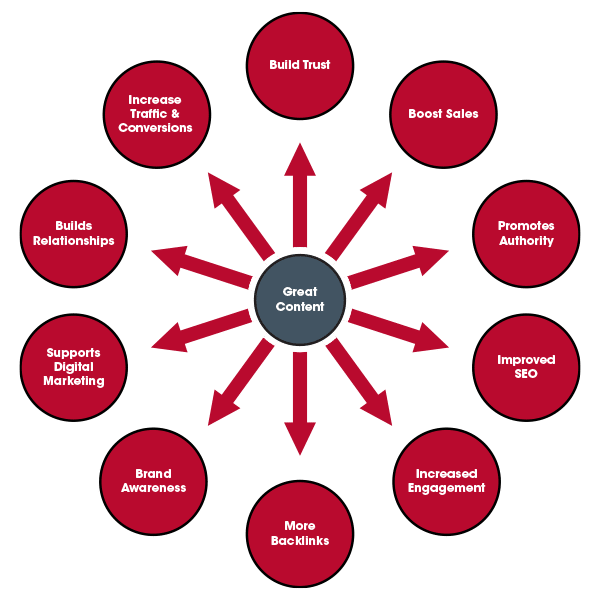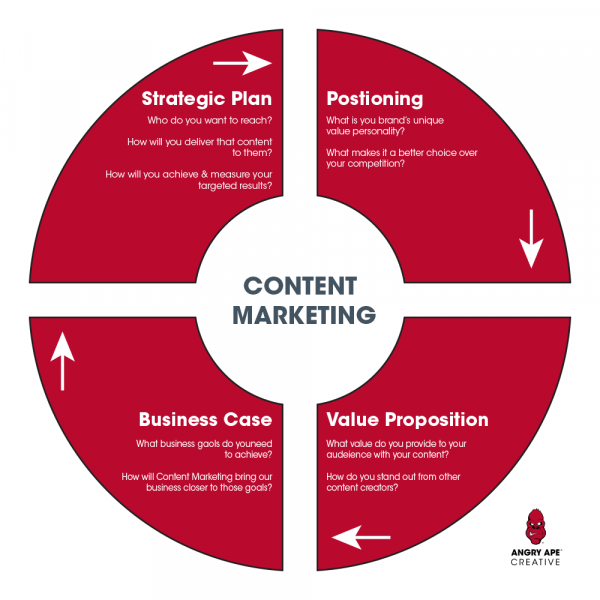Content marketing is the best way to give customers what they want to know; it’s a marketing technique that involves writing, curating, and sharing great content with the goal of building your reputation and brand visibility.
Among the many benefits, content marketing increases customer engagement, website traffic, greater lead generation, and media visibility. Almost all marketers use some form of content marketing, and customers love valuable, evergreen content. It gives curators time to produce quality content for customers with a great deal of flexibility, too. You can publish content remotely.
- 82% feel closer to a company with good content
- 68% spend time reading about brands that interest them
- 70% feel closer to a company because of content marketing
- 80% appreciate learning about a company through content
Content marketing can set you apart from the competition. With the right marketing plan, you can be an ever-evolving success as you share useful content with your readers.
What is Content Marketing?
Content marketing is when useful, high-quality content is supplied to customers via blog posts, videos, podcasts, newsletters, and other content.
The Content Marketing Institute defines content marketing best as a strategic marketing approach focused on creating and distributing valuable, relevant, and consistent content to attract and retain a clearly defined audience, driving profitable customer action.
Content Marketing Examples
Example 1
BabyCenter is a website full of parenting educational articles. The site is owned by Johnson & Johnson, a manufacturer of baby products. They are using content marketing because they are informing rather than selling.
Example 2
You own a floral shop and decide to start a blog. The type of content you offer your audience is relevant to your industry, but not overly promotional. Some of the content you included in your blog are:
- How to Start Your First Garden
- What Your Favorite Flower Says About You
- How do Gerber Daisies Get Their Color?
Example 3
Beginning in 1895, John Deere’s The Furrow magazine is another example of content marketing. It provides valuable, unbiased information for farmers. It isn’t trying to sell John Deere equipment, it is giving valuable information and content to the people that read it.
More Examples
Still a little unclear as to what content marketing is? The Content Marketing Institute has over 75 examples of content marketing in this complete list.
Why is Content Marketing Important?
A smart content marketing strategy gives customers what they want – valuable content that they are searching for. When you provide this information, you attract new customers and retain existing ones.
According to CMI, there are 3 key reasons why businesses use content marketing:
- Increased sales
- Cost savings
- Increase in customer loyalty
Content marketing generates three times as many leads as traditional marketing and costs about 60% less. In fact, this marketing method can help you align all your business key success factors.
What are the Benefits of Content Marketing?
For most industries, content marketing is a very effective marketing strategy, provided it is done correctly.
So, how can you achieve great content?
- Offer solutions to problems.
- Give customers what they want.
- Provide useful, evergreen content.
You can provide valuable content with the help of:
- Blog posts
- Social media updates
- Infographics
- Visual representations
- Magazines and eBooks
- Videos/Podcasts
- Educational resources
- Webinars and events
The key here is engagement! Keep your customers interested by giving them interesting things to read and look at. Let them interact with your content by offering:
- Quizzes, surveys, and polls
- Social media interaction
- Responses to comments
- FAQ’s
- Customer success stories.
Doing this humanizes your brand; customers want to buy from real people, not just a brand.
What is the Goal of Content Marketing?
According to Forbes, the goals of content marketing include brand awareness, brand loyalty, customer education, customer engagement, and the recruitment of talent.
Customer education is a crucial part of content marketing. As Forbes put it, “an educated client makes a happy client.”
Quality content also brings in talented employees. You want authors who can deliver meaningful, valuable, consistent content over those who write “fluff.”
When freelancers or other potential employees see that you write only the best, they will want to join in and contribute honest, thoughtful content that your customers will be keen on reading.
So, how can you achieve great content?
- Offer solutions to problems.
- Give customers what they want.
- Provide useful, evergreen content.
You can provide valuable content with the help of:
- Blog posts
- Social media updates
- Infographics
- Visual representations
- Magazines and eBooks
- Videos/Podcasts
- Educational resources
- Webinars and events
The key here is engagement! Keep your customers interested by giving them interesting things to read and look at. Let them interact with your content by offering:
- Quizzes, surveys, and polls
- Social media interaction
- Responses to comments
- FAQ’s
- Customer success stories.
Doing this humanizes your brand; customers want to buy from real people, not just a brand.
What is the Goal of Content Marketing?
According to Forbes, the goals of content marketing include brand awareness, brand loyalty, customer education, customer engagement, and the recruitment of talent.
Customer education is a crucial part of content marketing. As Forbes put it, “an educated client makes a happy client.”
Quality content also brings in talented employees. You want authors who can deliver meaningful, valuable, consistent content over those who write “fluff.”
When freelancers or other potential employees see that you write only the best, they will want to join in and contribute honest, thoughtful content that your customers will be keen on reading.
How a Content Marketing Strategy Works
- Define goals, perform audience analysis & evaluate the competition
- Create effective content
- Promote & distribute content
- Expand the content to maximize ROI
- Track & evaluate the content’s performance
How to Create a Successful Content Marketing Strategy
A detailed content marketing campaign is complex and comprehensive. This plan will help you define and execute exactly what you need.
Step One – Create and Evaluate Your Content Marketing Goals.
When starting any marketing strategy, it’s crucial that you understand why you are using this strategy, what you will need to accomplish it, and how the strategy will align with your business objectives.
By answering the questions from the Business Case section of Figure 4, you should have a full summary of how you are going to match your content marketing strategy with your organizational goals.
You need to make sure the content you create helps you meet your SMART goals. You can measure this by using content KPIs (Key Performance Indicators). Key performance indicators can help you measure your company’s long-term performance.
Content > KPIs > Goals
With the information obtained from your KPIs, you should be able to answer the following questions from the Business Case section of Figure 4 – The Content Marketing Solution:
- What business goals do you need to achieve?
- How will content marketing bring our business closer to these goals?
Step Two – Perform an Audience Analysis.
You can easily tell who your audience is by asking yourself the following questions:
- Who consumes my content?
- Who buys my product?
- Who would want to read about my industry?
In other words, according to the Strategic Plan of Figure 4 – The Content Marketing Solution:
Who do you want to reach? = Target Audience
Are you still unsure of who your audience is? Check out the following resources for help with that.
- HubSpot’s Developing Personas Worksheet
- Medium’s How to Develop Vibrant Profiles of Your Startup’s Ideal Customers article.
- Qualaroo’s smart surveys can help you group your customers into different buyer personas.
Step Three – Map Out Your Customers’ Needs for Your Products or Services.
This step goes hand-in-hand with the audience analysis you just did. You know who your audience is; now, what do they need?
Buffer defines content marketing as “solving the same problem or conveying the same emotion as your product, using media you create and distribute.” You must determine how you can help your customers.
What problems do your customers have? Your product or service should be the solution. You should be able to answer the following questions from the Value Proposition of Figure 4:
- What value do you provide to your audience with your content?
- How do you stand out from the other content creators?
To perform this step fully, you should map out your audience’s wants and goals. How do they align with the solutions you are selling? When you have this list, put it in a spreadsheet or documents with a brief description of each want or goal. This will help you paint a clear picture of content marketing.
Don’t forget to check out the competition.
- Where are your customers currently going for their desired content?
- What is the competition writing about?
It’s a good idea to have a firm grasp on what your competitors are doing for your customers.
Step Four – Monitor the Competition’s Marketing.
You need to know where your customers are currently going for the information they want to read. Find out who is competing for your audience’s attention. Discover how customers are getting what they want from your competition to better understand where you come into the mix.
Understand and answer the following questions:
- Who is competing for my audience’s business? These businesses are your direct competition.
- Who is competing for my audience’s attention but not necessarily their business? These businesses are your indirect competition.
Now that you have defined your competition, it’s time to answer the Positioning questions from Figure 4:
- What is your brand’s unique value personality?
- What makes it a better choice over your competitors?
Your content marketing goals should be to stand out with a unique approach to content and to capture a new demand with your content.
Don’t blend in with the crowd. Repetitive content breeds a lack of productivity for a non-existent audience. The key here is one-of-a-kind content.
Are you still unsure as to who your competitors are? Check out SEMRush. This tool can tell you who your competition is based on the keywords you are writing about.
Offer your customers something better content than what is already out there.
Step Five – Conduct a Content Audit and Begin Content Creation.
It’s time to take inventory of the content you have available. This will give you a list of all your content marketing assets.
Examples of these assets include:
- Your landing pages
- Syndication relationships
- Social blog
- Social media accounts
- Guest blog posts
A more in-depth look into your content marketing assets should consist of:
- A list of the keywords you rank for in the search engines
- All blog posts that are currently seeing significant traffic
- All active email lists
- All high-level webpages
- All your social media accounts
Some of the tools you can use to perform your content audit include:
- Screaming Frog
- SEMRush
- Google Webmaster Tools
- Moz
You have now run a thorough content audit and are ready to evaluate this content.
Types of Content
So, now you know what you have. What content do you need to create? Well, you now know what your customers need. It’s time to help them through your content.
The goal should be:
- Make them aware of what the problems they may have that they didn’t know about
- Offer them solutions to their problems in the content you provide
- Make them aware of the solution options your brand provides
Turn them from unaware to most aware of solutions to problems they didn’t know they had.
It’s time to answer one of the final questions from the Strategic Plan section of Figure 4 – The Content Marketing Solution:
- How will you deliver content to your audience?
Well, here’s a whole slew of ideas on how you can offer your customers the content they need:
- Blog posts
- Social posts
- White papers
- eBooks
- Infographics
- Live events
- Case studies
- Podcasts
- Web pages
- Demos
- Webinars
- Newsletters
- Mobile apps
- Interactive video
- VR experiences
- Augmented reality experiences
- Guides
- Games
- Data visuals
- Courses
- Animations
- SMS and push notifications
So, you know now what type of content you will be creating, it’s time to get busy writing (or letting your writers do their thing)!
Start by brainstorming what topics resonate the best with your audience.
Need even more ideas for your content? Check out this list from the Marketing Insider Group:
The Latest News
According to the Marketing Insider Group, as of Spring 2020:
“With 76% of marketers planning to produce more content this year, according to the latest B2B Content Marketing Benchmarks, Budgets and Trends Report from Content Marketing Institute and MarketingProfs, it’s becoming harder than ever to reach your target audience with so many other brands competing for the same eyeballs.
And creating more content isn’t always the answer. In fact, more isn’t necessarily better. While more brands are producing more content, the same report found that only 30% of marketers rated their organizations as effective at content marketing, down from 38% last year.”
Creating Content
So, the question is, “How can we create effective content?”
You need to have content that Google likes. Otherwise, your content will be buried on page 10 of the search engine results page, so what does Google want?
Proper SEO content will put you up at the top. It’s not always the easiest thing to accomplish, but with proper keyword research, you can do it. Just don’t stuff your content full of keywords, making it hard to read. It should naturally flow together.
Besides awesome SEO content, you need to provide E-A-T on your content pages. So, what is E-A-T?

Expertise
There’s more to being an expert than just knowing the subject front to back. You need to be able to communicate this information in an engaging and useful way, using visual cues and examples.
Authority
Here are a few ways you can do this:
- Provide links to credible, useful websites.
- Create content that is shared consistently throughout social media.
- Build a good, strong brand that people are talking about.
- Consider having a Wikipedia page about your brand.
Trust
Create trust by having a way to contact the website owner, such as an email, physical address, and phone number. Show you are a real person.
Have a secure website; create terms and privacy policy for your website; be specific of anything you are selling on your website, and be clear as to your return policy. Readers want to feel confident and secure when they read your content.
Step Six – Evaluate Your Content.
It’s time to line your content marketing assets up against your content marketing goals. You need to see which pieces of content are aligned with your business goals properly.
Map out your content in a matrix like this:
The X-axis of this matrix uses performance measurements like page views, likes, shares, rankings, and comments. The Y-axis of this matrix plots the alignment of the company’s goals with the content. The higher up the content is, the more aligned it is with your goals (Kranz, 2018).
Analyze your content by using this matrix and make any adjustments needed. Which topics are resonating with your audience? Why are these favored? Write down your answers.
Now, adjust your content marketing plan to produce content that hones around these topics. As you analyze the results of your evaluation of the content you published, you should now be able to answer the final question in the strategic plan section of Figure 4 – The Content Marketing Solution:
- How can you achieve and measure your targeted results?
Step Seven – Analyze the Content Team, Workflow, and Content Capacity.
Now that you understand which of your content pieces fall under winners and fixer-uppers, you can determine what type of content needs to be made. You should now understand which content resonates the best with your target audience.
As you work with your content team, be sure that they understand SEO and the proper use of keywords. Ensure they know how to research keywords and use the right keyword density in their writing.
Next, you need to analyze your content team and the workflow they can handle. Your content team should consist of your in-house writers and designers. The workflow process should be something like this:
IDEAS > WRITE > DESIGN > POLISH > SCHEDULE > PROMOTE
The final piece to analyze is the content capacity you have. How much work can your workers handle? Remember, quality work takes a bit more time, so have reasonable deadlines.
Evaluate your content capacity by using a chart or spreadsheet like this example:
Step Eight – Create an Editorial Content Calendar.
What is an editorial calendar? HubSpot defines an editorial calendar as “a visual workflow that helps a team of content creators schedule their work on a daily, weekly, or monthly basis. Editorial calendars can help you track content types, promotional channels, authors, and, most importantly, publish dates.”
You can create an editorial calendar with Google Calendar or in Trello; then, you can share it with your content team. There are many free printables you can use as editorial calendars at the end of this article.
Step Nine – Promote Your Content.
Once you have your awesome content written and published, it’s time to let the world know. Email your customers to let them know about the new content. Ask them to share it with those who would be interested in the material.
Share the content yourself on social media and via guest blog posts. Use social networking to spread the word. Social media and content marketing go together hand in hand. Along with your editorial calendar, you should consider using a social media calendar, a tool that will guide you in posting the news of your new blog post to all the social networks you are a part of.
Step Ten – Write an Executive Summary.
Gather all the information you have collected in steps one through nine and write an executive summary of your content marketing plan. Use this summary as a sort of introduction to your plan.
Include
- the goals you are hoping to accomplish
- where you are at with the content currently
- what needs to be adjusted to better align with the company’s goals
- how you will make it all happen
This is an excellent tool to use to summarize your entire marketing strategy plan.
Free Content Marketing Templates
- Smartsheet has over 60 free content marketing templates for you to choose from. Included are content marketing strategy templates, checklists, workflow templates, editorial calendars, content improvement worksheets, and much more!
- HubSpot has the ultimate collection of free content marketing templates. They offer content planners, calendars, editorial content templates, social media content templates, email content templates, and more!
- Christine Ellis has eight free content templates that should save you hours of work. They include the following templates: content audit, content strategy, editorial calendar, content distribution, Google Analytics, and a few more.
- The Content Marketing Institute has a content marketing toolkit with tips, templates, and checklists. Some of the offerings there include a publishing guidelines cheat sheet, a DIY editorial calendar, an accuracy checklist for content marketers, and a content marketing dashboard for you to track your performance.
Conclusion
You should now have a solid understanding of what content marketing is, why it’s important, the many benefits you can gain from it, and how to create a thorough content marketing strategy. There are many free printables that can help you every step of the way, too.
So, what are you waiting for? It’s time to break out a calendar and big legal pad, get to answering the many questions provided in this article, and create a content marketing strategy that will make your business successful.
Jay Bilunas is a graphic designer and marketing consultant. He loves helping small businesses succeed with great marketing and design. He also teaches and tries to help up and coming designers.
- Jay Bilunashttps://angryape.com/author/angryape/
- Jay Bilunashttps://angryape.com/author/angryape/
- Jay Bilunashttps://angryape.com/author/angryape/
- Jay Bilunashttps://angryape.com/author/angryape/









-300x158.png)


